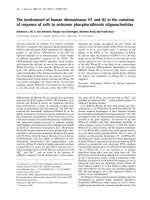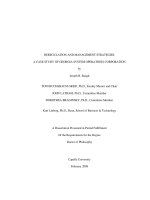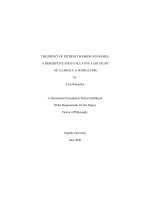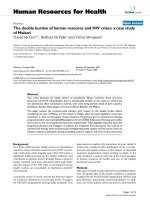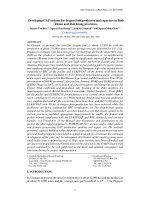A guideline for human trafficking prevention and suppression in a police station level: Case study of Samut Sakhon police station
Bạn đang xem bản rút gọn của tài liệu. Xem và tải ngay bản đầy đủ của tài liệu tại đây (607.03 KB, 8 trang )
A GUIDELINE FOR HUMAN TRAFFICKING PREVENTION AND
SUPPRESSION IN A POLICE STATION LEVEL: CASE STUDY OF
SAMUT SAKHON POLICE STATION
Pol.Lt.Col. Pimapot Nomchobpitak
Faculty of Police Science, Royal Police Cadet Academy,
Sampran Nakornpathom, Thailand
Abstract
Human trafficking is one of the most important issues around the world which is an
international crime and a new threat to national security. Thai government too does not
hesitate to eradicate human trafficking issue. Law enforcers „Police officers‟ play a vital
part in human trafficking prevention, suppression, controlling and bringing the case to
judicial procedure. In order to enforce involving laws to the maximum effectiveness, law
enforcers, who are working on human trafficking prevention and suppression, have to be
empowered by the government supports. The police officers in provincial police station are
the main target of aforementioned empowerment since they are the closest to the
community as well as the problem.
Keywords: Guideline, Prevention and Suppression, Human Trafficking, Police Station
1. Introduction
Rationale and Background
Human trafficking remains one of the biggest problems in Thailand and the world.
Because human trafficking violates the being of human right which is the major concern of
the community around the world. Moreover, the human trafficking is a new form of
national security threat. Therefore, this human trafficking is the major issue which
countries including Thailand have to raise more awareness and cooperate to eliminate the
problem. Thailand government has declared that solving the ―Human Trafficking‖ to be
Thailand‘s national agenda on August 6, 2004 aiming to eradicate human trafficking
problem. After that, on April 3, 2015, the Prime Minister announced the ―Human
trafficking‖ to be national agenda which required all of the relating department to
integratedly work together under the concept of ―Pracha-Rat Ruam Jai Tarn Pai Karn Ka
Manud (Public-Private works together to solve human trafficking problem)‖. Then, the
strategic policy and measure to prevent and suppress human trafficking has been
determined (2011 - 2016). The strategy and measure were created to be the tools for
steering the process of the 20 years national‘s roadmap strategy (2017 - 2036) in the terms
of Human Security.
Although Thailand has been putting the effort to execute the human trafficking
prevention and suppression policies including Human Trafficking prevention and
Suppression Act 2008 and important law mechanism, the outcome of the effort did not
605
meet the lowest requirement in Trafficking in Persons Report (TIP Report) yielding the
negative report toward human trafficking prevention and suppression situation.
Thai Royal Police is one of the departments that take a major role in human
trafficking prevention and suppression. Apart from setting special Crime Suppression
Division to counter this problem particularly, Thai Royal Police also applies management
measure to prohibit police officers to get involved to human trafficking as well as develops
and improves human trafficking cases database to be up-to-date which connected to related
organizations. Other than that, the department also develops Thai Royal Police 20 years
strategic plan phase 1 (2017 - 2036) focusing on human trafficking missions consisting of
preventing and suppressing human trafficking crimes as well as enhancing human
trafficking preventability and suppression capacity.
However, in order to fully enforce the law against human trafficking, despite of the
clear terms and definition of the lawsuit itself, legal punishment has to be appropriate to
the severity of the crime. There has to be the composition of procedural supporting factors
whether in prevention work or in suppression work for police officers who take part in this
human trafficking prevention and suppression in the level of police station which is the
root of all related works.
From the study of Wanna Changjanya (2014) which is the study of human
trafficking prevention and suppression of Thai Royal Police 2nd Sub Division The AntiTrafficking in Persons Division, Thai Royal Police. It was found that there are four
obstacles in anti-trafficking works, those are: 1) In planning aspect; It was found that
budget and resource are not adequate to the plan rendering the officers cannot follow the
plan. 2) In managing aspect; It was found that staff number is insufficient and lack of
cooperation among other organization. 3) In leadership and line of command; It was found
that the orders do not cover as well as the hierarchy of command makes the order blurred.
4) In controlling aspect; It was found that controlling power does not cover all of the staffs.
The government determined Samutsakorn province to be one of seven human
trafficking risk provinces including Samutsakorn, Chon Buri, Chachoengsao, Rayong,
Nakhon Si Thammarat, Songkhla, and Sa Kaeo because those provinces are the place that
have a lot of influx alien labors. The labors are Burmese 200,001 people (93.87%),
Cambodian 10,323 people (4.85%) and Laotians 2,692 people (1.26%). The Burmese
labors living in Samutsakorn mostly are Mon scattering around the province, Amphoe
Krathum Baen, and Amphoe Ban Phaeo, especially in Amphoe Muang Samutsakorn there
are 73 communities defined to be high-dense residential area (Alien labor hiring situation
of Samutsakorn province, 2017)
It is recognizable for the researcher that studying current situation of human
trafficking prevention and suppression of the officers, who take a major part in strengthen
the counter measure of this issue, in the level of police station is a vital. The officers have
to control the area allowing the police officers work more effectively. The officers, the
main pillar of human trafficking prevention and suppression, have to be agile in taking and
execution received orders and be able to work with other organization harmoniously. The
606
research is the case study of involving officers who take part in human trafficking
prevention and suppression task in Samutsakorn police station level. In addition, the study
also probes the cooperation guideline among related organizations yielding integrated
cooperation from all related departments to counter trafficking problem leading to
executable practices for other organization according to the government and National
Council for Peace and Order (NCPO) policy.
Related Theory
Iceberg Model
David McClelland has given the implication of competency in the book ―The
Competency Foundation‖ which described human characteristic to be as same as iceberg
Tip of the iceberg, the ‗visible‘ part:
1) Skill means the things that man knows and has capability to do them well such as
reading skill, listening skill, driving skill, etc.
2) Knowledge means the things that man knows and understands to its particular
concept or idea; for example having knowledge about accounting, having knowledge about
marketing or politics, etc.
Body of the iceberg, the ‗hidden‘ part:
3) Social Role means the things that individual needs to let other people know how
he contributes to the social e.g. He likes to help other people etc.
4) Self image means the reflection of how one sees himself e.g. leadership,
expertise, or artist, etc.
5) Traits means the habits which would be permanent behavior e.g. clam, humble
and sportsman.
6) Motives mean the drive within one‘s self affecting one‘s action e.g. the need for
success then all the actions leads to success all the time.
Participation Theory
Having Working or giving opinion participation is essential and important for
human resource nowadays yielding directly and positively increasing in subordinates‘
performance which is good for executive‘s commands. The executives have to listen to
staffs opinion and to build staffs‘ relationship. Staffs are going to feel they belong to the
organization which ultimately leads to unlock their potential and invest their blood, sweat,
and tears to the organization‘s mission granting the outstanding outcome and excellent
performance.
Law Enforcement Theory
Sir Robert Peel, namely ―The father of modern police‖ founded London
Metropolitan Police Department on 1859, emphasized the staffs to realize that preventing
crime is more important than anything. Investigation, arresting, and punishment, in Peel‘s
607
opinion, became the foundation of the concept of the using of law enforcement for prevent
crimes. The main police‘s strategy to prevent crimes according to the law enforcement
theory is patrolling which is the backbone of police task. The essence of this theory is the
appearance of the officers has crime suppression effect because criminal will afraid of
being caught. Therefore, patrol officers have to wear uniform, and the vehicle has to be
easily spotted in order to intimidate those potential criminals. Other than that, regularly
patrolling in such area makes community members feel like polices are everywhere. For
this reason, according to law enforcement theory, the appearance of police officers and
patrolling can prevent crimes, since they minimize the opportunity to commit crimes. In
addition, patrolling could be routine job or special task. In terms of routine job, responsible
areas are assigned to the patrol officers to prevent and suppress within their shift. In terms
of special task, all of patrol officers in the area are standby and immediately present in the
area after receive the order from headquarter.
Crime Triangle
The Crime Triangle Theory can describe the cause or the factors of crime including:
1) Offender / Criminal means a person who has desire to commit crime.
2) Victim means person, place, or object on which is the target the criminal has the
desire to take the action.
3) Opportunity means time and location which is suitable for committing a crime.
When the triangle is completed the crime occurs. The theory has presented the
concept of crime solving or crime prevention by attempting to intercept the cycle before it
completes or eliminating a side of the triangle.
Situational Crime Prevention
While Crime Triangle helps prevent cause or factors of crimes, Situational Crime
Prevention can prevent crime according to these five concepts those are: 1) raising
difficulty to commit crime to the criminal 2) raising the chance of the crime being detected
3) reducing reward for criminal 4) eliminating the excuses for committing crime 5)
avoiding or reducing the motive
Community Policing
Community policing is the new concept of the crime prevention. It believes that
creative cooperation between police and community can solve crime related problems, feeling
of fear, criminal threat, as well as social disorganization and social degradation. In order to
achieve that, policing unit have to develop a good relationship with good men living in such
community; and, let them have a chance to express their opinion, suggestion, and problems
prioritization as well as improve the quality of the community in which they live. In the other
words, the principle of community policing is the principle of the policing mission which
promotes and supports the ‗strike to the root of evil‘ in order to reduce the problem of
criminals and community disorganization which require cooperation between police and
community. The priority of problem will be selected by people living in the community.
608
Research Framework
IN
PUT
- general condition
- Length of time
- Staffs
- budget
- tools
- management
- moral/ethnic
- Procedure Method
Technique
- Information
Cooperation/
compromising
PROCESS
SWOT Analysis
- Role
- Related Department
- Operation Process
- Participation in
improvement
- Ice Berg Theory
(Concept Competency)
- (POCCC) Planning,
Organizing, Command,
Coordinate, Control
- (IT) Information
Technology
- Cooperation Theory
- Law Enforcement
Theory
- Situational Crime
Prevention
- Community Policing
Guideline for
Human Trafficking
prevention and
protection
OUTPUT
Guideline for Human
Trafficking prevention
and protection in police
station
- Prevention
- Protection
- Jurisdiction
- Knowledge
OUTCOME
building strength and
expressing 21st century
human potential pushing
social and economic
forward
FEEDBACK
Be able to use in improvement of all processes
Image Research Framework
Literature reviews
Human trafficking situation in Thailand
Thailand, according to Trafficking in Persons Report 2014, was ranked to be Tier 3
of the ranking which means Thailand did not fully follow the minimum requirement and
has no attempt to follow the requirement. In the other words, Thailand is in the worst
situation of human trafficking after has consecutively struggled in Tier 2 watch list for 4
years. From that cause, in June 2016, Thailand still ranked in Tier 3 country which is the
group of the worst situation in human trafficking.
The impact of human trafficking in Thailand
The downgrading in human trafficking situation from tier 2 to tier 3 has impacts on
Thailand in 3 aspects, those are:
609
Firstly, the overall trading image between Thailand and US, especially on fishery
products e.g. shrimps and tunas, ranking in tier 3 means US could use this as a loophole to
boycott Thailand‘s products. The United State would consider to boycott Thailand within
90 days counting from the demoting date. If Thailand was boycotted, the result would
highly affect frozen food industry and shrimp industry because US is the main target of
shrimp export (40%) and tuna export (20%). Moreover, it would have psychological
impact which competitors countries may exploit to discredit Thailand‘s trading industry.
Secondly, staying in bad situation in human trafficking will destroy Thailand‘s
image on the world‘s stage which may negatively affect investment trending in Thailand as
well as ceasing in helping on various aspects. Although the United States did not declare
the boycott to tier 3 countries, the message has been spread and had negative impact on
Thailand‘s image. Some foreign companies may now reconsider their investing policy in
trafficking related industries in Thailand e.g. fishery industry. Other than that, Thailand
may lose some other non-trading and non-humanity related helping from US as well as
may be refused from other international organization e.g. IMF and World Bank, etc.
Lastly, It impacts national security and social problems. Thailand might be labeled
labeled as human trafficking country from other countries especially the United State;
because, Thailand has three status of human trafficking including 1) the gateway country
of trafficking 2) the channel of trafficking and 3) the trafficking site. In addition, human
trafficking cartels mostly are criminals and have illegal work which are hard for police
officers to suppress and control.
Human trafficking problem in Samutsakorn province
From the alien labor hiring in Samutsakorn reported in January 2017, it was found
that there are 291,731 workers who have work permit; mostly they are Myanmar 255,933
people (Samutsakorn Department of Employment, 2017) comparing to the data from June
30, 2016, there were 262,237 alien labors. From the speculation, it was found that there are
legit labors more that illegal labors i.e. 144,590 legit labors (55.14%), and 117,647 illegal
labors (44.68%). For Laos, Burmeses, and Cambodians, according to the parliament,
213,016 of them (200,001 Burmeses, 10,323 Cambodians, and 2,692 Laos; 93.87%,
4.85%, and 1.26% respectively) were temporarily allowed to work in Thailand.
Research Objectives
1) To study the condition of the problem in human trafficking prevention and
suppression tasks for provincial crime prevention and suppression officers in Samutsakorn
and related public and private organizations.
2) To study supporting factors to enhance performance in human trafficking
prevention and suppression for the officers in Samutsakorn metropolitan police station.
3) To find the guideline for counter human trafficking problems for prevention and
suppression officers in Samutsakorn metropolitan police station.
610
Anticipated Benefits
1) Thai Royal Police department acknowledges the problems of human trafficking
prevention and suppression tasks of the officers in working with private organizations and
police officers in the police station
2) Thai Royal Police department acknowledges the guideline for improving the
effectiveness of human trafficking prevention and suppression tasks of the officers involved.
3) Police station has the guideline for executing human trafficking prevention and
suppression tasks and its benefit could also expand to the other field.
4) Police station has the guideline for cooperation with related organizations.
2. Method
Criterions for data givers are:
1) the officers who currently work in human trafficking prevention and suppression and/or
2) working in human trafficking prevention and suppression task for at least 5 years and
3) having experience in human trafficking prevention and suppression at least 5 years
The participants are consisted of Samutsakorn provincial and district officers (15
people), private organization staffs (3 people), and Samutsakorn police officers (30 people)
Research Tool is in-depth interviewing about:
1) The condition of problem of the Samutsakorn provincial and district police
officers who work in the operation of human trafficking prevention and suppression and
related private organization. The interview includes role/duty, operating process, related
organizations, operation participation, the length of the operation, the cooperation of police
officers, police officer‘s needs, and organization SWOT.
2) Samutsakorn metropolitan police officers‘ performance enhancing factors in
operation of human trafficking prevention and suppression i.e. the readiness of 8M
management, budget, tools, management, moral/ethnic, procedure, method, technic,
information, cooperation/compromisation.
3) Guideline for human trafficking prevention and suppression operation for
responsible officers i.e. staff empowerment, working cooperation, staffs management in
the station, utilizing information technology (IT), crime prevention and suppression
management (Law Enforcement Theory and Crime Triangle)
Data Collection
1) Secondary Data is the collection of paper works which the researcher studies and
collects from documents, academic books, official letter, journals, academic papers, thesis
and research reports, related statistics, printed materials, and internet based resources.
2) Primary Data is the collection of fieldwork using person-to-person interviewing
technique to related staffs. The researcher has sent letter for courtesy asking for their help,
and made an appointment for interview giving them time for preparation.
Data Analysis
The data analysis is from data collected from documents and interview following
method, process, and objectives of the research. Utilizing literature review in chapter 2 also gives
the meaningful analysis as well as grants rich and depth details of the phenomenon for us.
611
3. References
1. Department of Anti-Trafficking in Person, Ministry of Social Development and Human
2. Security. (2012). Operational Guideline on the Prevention and Suppression
of Trafficking for Staffs. Bangkok: Religious Printing House.
3. Operational Guideline on the Prevention and Suppression of Trafficking for
Labour Purposes and Assistance and Protection for Trafficked Persons (Revise Jan 10, 2017).
4. Pachara Santad and Chet Ratchadapunnathikul.(2014).Police Administration in
Human Trafficking on Prevention and Suppression of Metropolitant Police Stations.
Journal of Thai Justice System. 7(1) : 1 - 15.
5. ___________ . (2559).Management of The Party Network for the Prevention
and Suppression of Human Trafficking in Thailand. Journal of Thai Justice System.
9(1) : 23 – 41.
6. Pattrawan Vechasart.(2558).Integrated Approach for Combating Trafficking in
Persons.National Defence Studies Institute Journal. Vol. 6 No.4 Sep - Dec 2015. The
Trafficking in Persons (TIP) Report 2017 US.
7. Samutsakorn Ministry of Labour.(2016). Samutsakorn TIP report Q2 2016.
From . accessed on October 24, 2017.
8. ___________ . (2560).Samutsakorn Alien Labour Hiring Report January
2017.From . accessed on October 24, 2017.
9. Sompong Srakaew et. al.(2015).A Report on Migrant Children & Child
Labourers in Thailand‘s Fishing and Seafood Processing Industry of Samutsakorn
Province.Labour Rights Promotion Network Foundation (LPN).
10. Wanna Changjanya.(2014). Administration of Human Trafficking
Deterrence and Suppression Conducted by Sub-Division 2, Anti-Human Trafficking
Division, Royal Thai Police, Headquarters. Special problem. Master of Public
Administration Program, General Management, Graduate School of Public Administration,
Burapha University.
11. Sira Sawangsil. (2014).Administration of Improving Thailand Human
Trafficking Law Enforcement Potential: The Study of Trafficking Victims Protection
Act 2000 Comparison between United State and Thailand The Anti-Trafficking in
Persons Act 2008. Individual Study. Bangkok: Devawongse Varoprkaan Institute of
Foreign Affairs, Ministry of Foreign Affairs.
12. US Embassy.(2014).Trafficking in Persons Report 2014. From
Accessed on August 10, 2017.
13. Sarayut Yahakorn.(2015). Human trafficking in Thailand
Vol. 5 No.2 July - December 2015.
14. Academic Department,The Secretariat of the House of Representatives.(2015).
Human Trafficking Prevention and Suppression : National Agenda.Electronic Journal.
/>15. Sangjan Manoi.(2014).Thailand's operation for anti-Trafficking in
Persons.Academic Department, The Secretariat of the House of Representatives.
612




